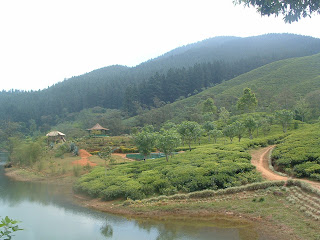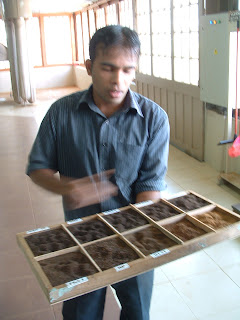"We're going to Elkaduwa this weekend, so pack your bags and let's go!" Dylan said on the phone to my friends and me. Dylan Perera is a talented young Sri Lankan musician whose group of friends I call family here.
I looked on the map to see where Elkaduwa is located, and found it in tiny print just north of Kandy in the central highlands of Sri Lanka. We packed our bags and headed to the bus depot, not knowing what was in store.
Dylan and a couple of his friends had been to Elkaduwa a couple times before, escaping to the cool hills, getting far, far away from the working world of Colombo that many young and frustrated people know and abhor. As Dylan said, "It's nice not to be harassed by cops or smell urine for a little while." But getting there, getting anywhere by '3rd class' public transit, is an extension of Colombo's perspiration-enducing claustrophobia, making one's arrival even more of a sweet reward.
We climbed into one of many squeaky, busted buses going to Kandy, beginning our clamoring, chaotic journey of many hours to Elkaduwa. Once we arrived in Kandy 3 hours later, we got onto another local bus to where it terminated further into the hills, and from there, in the dark hours of early nightfall, we began bartering with three-wheelers to get us up to the Elkaduwa Estate. Six of us piled into one three-wheeler and held on tight as we bounced through pock-marked roads, climbing higher and higher into the starry night. The three-wheeler dropped us at the entrance to the estate, but in the morning we would come to learn that he had really dropped us much before he should have. Let's just say it's hard knowing exactly what's happening when you're fumbling around in the dark in a new place...
We walked up concrete roads and along rocky footpaths for about an hour, guided clumsily by two flashlights amongst us, alternating between staring closely at the terrain and admiring the view of the stars above us, a rare treat for this urban gang. The fresh air helped us forge ahead, and finally we arrived at the Elkaduwa Estate entrance, where two men kept guard throughout the night.
Dylan, who had met these guys before on his previous trips, arranged our lakeside hut for the night. One of the workers, Lechema, walked us to his humble abode, where he woke his wife to make us a hot cup of tea and lend us an extra blanket. I felt so badly that we were disturbing this family who already toils all day long to make ends meet, but my friends assured me that this hospitality, this humble welcoming with tea and warm smiles, is assuredly intrinsic--even at midnight.
Lechema and his trusty mutt guided us up the estate through more irrigation ditches and footpaths to the lakeside hut which would be our home for the night. The sliver of the moon and a thousand stars reflected off the lake, showing us the outline of what splendor we would awake in the morning to find at our feet.
After listening to the tunes of Imaad and Dylan for a couple hours, I could hardly sleep with the cold air nipping at me on top of the chilly concrete slab, a full 180 degree change from the sweaty, clingy nights of Colombo. Of course, all five boys didn't seem bothered, snoring away after enjoying a couple arrack and Cokes. I think I finally got to sleep right after the sun came up and lit the lake on fire with an orange glow; I could now see the lake and the low forest behind it, flanked on one side by a steep hill of manicured tea. This dream was real.
The next morning, we woke to the sounds of birds chirping and leeches sucking. EWWW, leeches! Poor Danny had a small pool of blood laying at his feet, small holes on his ankle showing where the blood sucker had been the night before. The boys had warned me against the leeches, but like they warn me against everything and anything, real and imagined, I didn't know whether to believe them or not. The rust-colored stain on the thin mattress showed that they were indeed serious.
A couple of the boys made fishing poles and began digging for worms as bait. They managed to catch a couple small fish, but our breakfast consisted of tea and noodles courtesy of Lechema, who informed us that more guests were coming soon to use the 'cabin' and we needed to get ready to leave. It felt as though we had just arrived, and already we had to leave this magical place.
Now in full daylight, our walk through the Elkaduwa Estate illuminated what we did not see in the night: the rows upon rows of tea bushes being tended by Tamil ladies, and a dramatic rise and fall of the rocky landscape, and small villages where children played and washed clothes in the river. After hours of delightfully descending the hills we had climbed so cluelessly in the dark, we dragged our feet as we returned to Kandy and finally, Colombo.
The Elkaduwa Estate has been supported by CIDA, the Canadian International Development Agency.
The Elkaduwa Estate once maintained its own tea factory for drying, fermenting and processing the tea leaves, but now the building stands unused and eerie-looking, almost reminiscent of a Nazi concentration camp train station. The haunted and abandoned look, garnished by weathered barbed wire, stands in contrast with the cheery upkeep of the landscaping surrounding the edifice.
I awoke to find this reflection of tranquility at my feet.
Susa and his homeboys brought in a selection of guppies, a sure feast for Lechema's family when smothered in curry!
Tamil women picking tea leaves at Elkaduwa Estate.
Care for a swing in the sea of tea?
The small building to the far left is where we slept for the night, lapped by the lake's tiny waves and cradled by the pine-dense valley facing us.
The grounds near the sleeping cabin were nicely planted with ornamental flowers and native species.
This is another example of the housing which accomodates the tea plantation workers, sometimes called line housing because of its linear model, housing many families in often very cramped conditions. Over the years, many tea workers have addressed some of their working and living conditions, being represented by workers unions and steadfast agricultural rights groups. There is still much work to be done in securing this vital but vulnerable group of workers their due compensation and dignity.
There are marvelous rocks that suddenly jut out of the crafted, contoured landscape, like a hiccup in the monoculture of tea. The light green leaves at the top of the tea bush are what is harvested for making tea.
Imaad, Lechema, Susa, Dylan, yours truly, and Danny, striking a pose before we leave Elkaduwa Estate.

And so we journeyed on, over the hills and through the tea...






















































